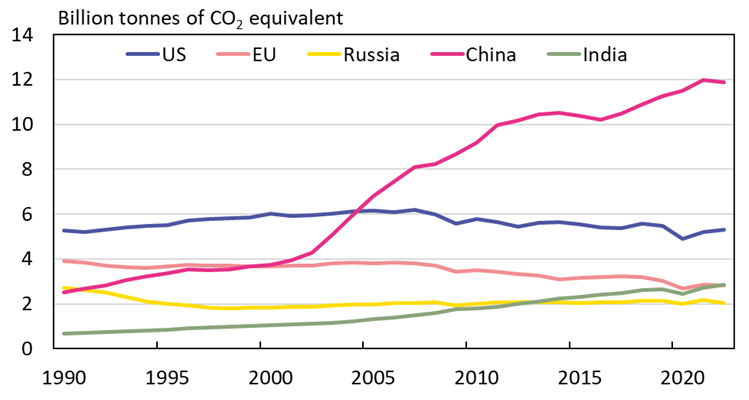BOFIT Weekly Review 48/2023
China critical to resolving global climate issues
The United Nation’s COP28 opened on Thursday (Nov. 30) in the city of Dubai in the United Arab Emirates. This year’s 2-week event (Conference of the Parties to the UN Framework Convention on Climate Change) is expected to attract tens of thousands of guests from nearly every country in the world. Topics include evaluation of global progress in hitting the climate targets agreed in Paris in 2015, necessary increases in investment in the green transition and accelerating the move away from fossil fuels. Following last year’s COP27 in Egypt, the parties voted to establish a loss and damage fund to assist poor countries in mitigation of climate change effects and address the harms caused by emissions. This year’s meeting will take up the critical details like the financing of the fund. The discussions in Dubai are expected to be difficult. It is significant, however, that China and the United States, the world’s two biggest carbon emitters, agreed two weeks ago to re-engage in high-level bilateral talks on climate issues.
China, by far the world’s largest emitter of greenhouse gases, is a key factor in reducing climate disruption. Although the country continues to build coal-fired power plants and has accounted for about half of all global coal consumption in recent years, it has also made prodigious efforts to increase the use of renewables. About 40 % of global wind power and solar power generation capacity is in China. In addition, the country has significantly increased electricity production at its nuclear power plants, making it the second-largest generator of electricity from nuclear power plants in the world after the US. Moreover, China is serious about electrification of its transport system. Over half of the global fleet of electrical vehicles now operates in China. Large investment in green technologies and capacity to produce such technology has given China an important role in global decarbonisation efforts.
China’s leadership has targeted its declining CO2 emissions to commence by 2030 and reaching carbon-neutrality by 2060. The slight drop in China’s carbon emissions last year reflected its struggles with covid lockdowns and restrictions; emissions this year are up as economic activity has revived. Two research institutes – the Centre for Research on Energy and Clean Air (CREA) and the Heinrich Böll Foundation – last week jointly published their second annual assessment of Chinese greenhouse emissions. The study notes that China could begin to reduce emissions in just a few years as long as the country’s heavy investment in green energy technologies continues. The sharp downturn in China’s construction sector has also helped reduce emissions. On the other hand, China continues to build considerable numbers of new coal-fired power plants. Clinging to coal assures that the country will miss its official target for reduced energy intensity (energy consumption per GDP), but also more makes the achievement of China’s long-term emission targets more daunting.
China has been the world’s largest producer of CO2 emissions for a two decades
Sources: BP Statistical Review of World Energy and BOFIT.